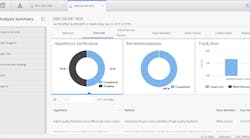“The convergence of OT and IT is where GE is different,” said Eddie Amos, vice president, applications at GE Digital. “Because we design, build, operate, maintain, and service industrial machines that operate in some of the harshest environments on the planet, we understand the stages in the industrial lifecycle of equipment like no other company.”
More than 50 of the world’s leading power producers and utilities have now committed to digitally transform their operations using APM on Predix. Those customers collectively represent approximately 20% of the world’s total thermal-electricity-generating capacity, says GE. Many are building digital-driven facilities to enhance operations and management of remote sites to better predict and prevent outages before they happen. APM is helping increase the reliability of the power supply in their regions.
Machine and Equipment Health, a foundation module for the APM suite, offers an always-on unified view of an asset’s current state and health. With real-time contextual views of asset health, status and issues from the edge, the cloud or a hybrid environment, operators can efficiently take action through connectivity to EAM or other work management systems. These views are produced by merging data from operational technology (OT) and information technology (IT) systems, alarms and events.
The Reliability Management solution in GE Digital’s APM suite aims to reduce unplanned downtime and boost predictable production by forecasting equipment issues before they occur, helping customers evolve from time-based maintenance to predictive, therefore improving productivity and operator efficiency. Companies can reduce costs by planning maintenance at the right time, focusing resources only where they are needed and reducing overtime and cost of spare parts. Reliability Management also helps to lower risk to workforce and improve safety by identifying bad actors and helping to eliminate potentially disastrous asset failures.
GE Digital’s APM Compliance and Integrity Management solution helps companies manage risk by monitoring changing conditions by supporting inspection methodologies such as API
580 and 581, and enabling compliance with OSHA 1910.119 Process Safety Management requirements and ISA/IEC standards. Compliance and Integrity Management features a new Management of Change (MOC) capability that provides a flexible solution for creating and managing change projects, communicating changes, and enforcing an approval system to provide implementation accountability. Users are able to comply with change management requirements and achieve a greater degree of auditability for regulatory compliance, according to GE.
The Asset Strategy and Optimization (ASO) module/solution intends to help customers optimize availability, reliability, risk, and costs by using intelligent asset strategies to determine the best approach for performing maintenance, inspection, or redesign activities. Using ASO, companies can simulate scenarios that balance risk and cost, allowing them to deploy different strategies in various work-management and control systems for complete integration and improved productivity.
“The stakes are extremely high for industrial asset failure and asset data must be analyzed as such,” continued Amos. “APM is a perfect solution for this task. As data loops accelerate and the time between data collection and meaningful action gets shorter for industry, machines and infrastructure systems are becoming engines of innovation.”


